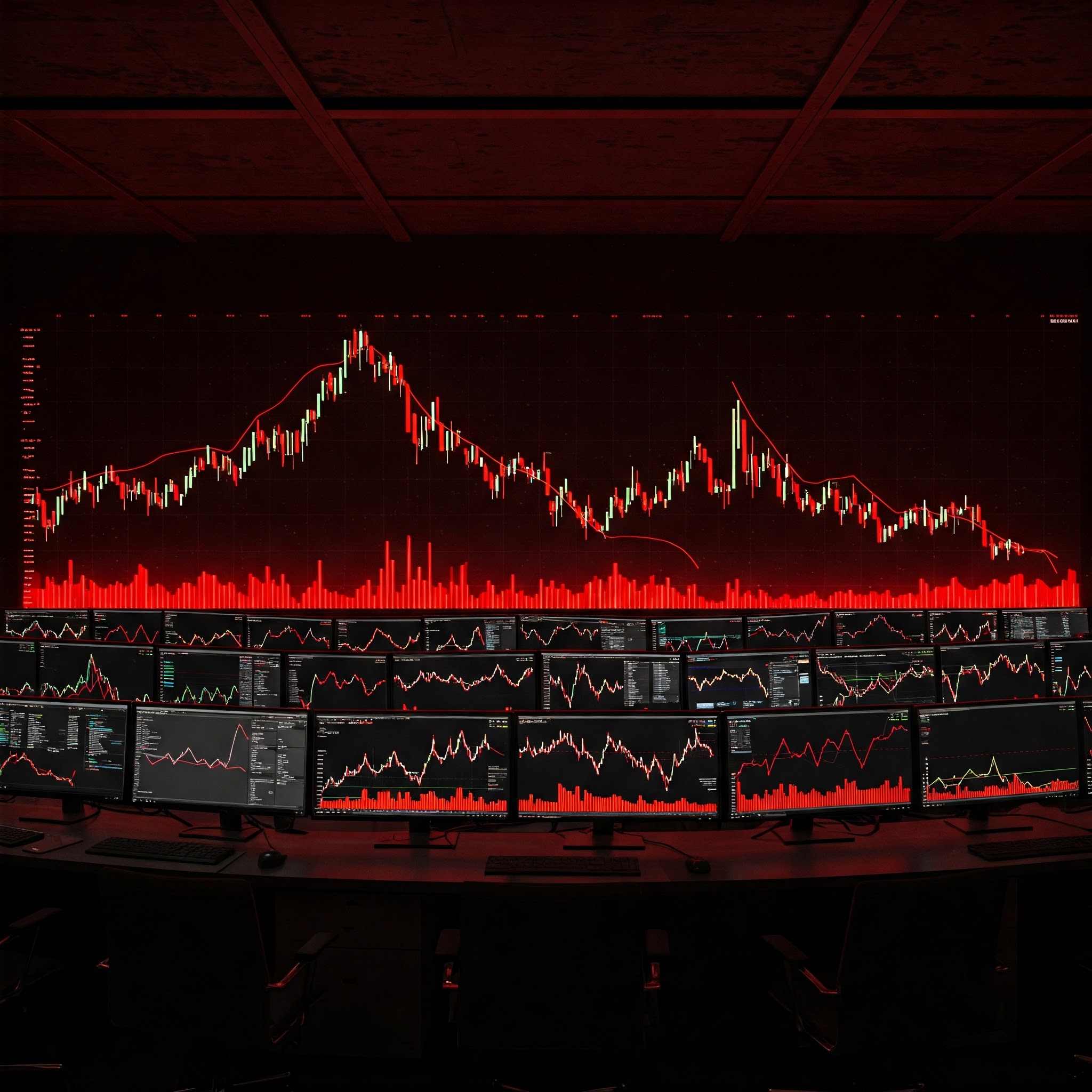In my last article, I talked about if XRP has reached its peak. I went over why some people might believe that as well as reasons why that is actually not the case. Well now we’re going to take a closer look why people may now regard XRP and other cryptos may have reached their peak. People wonder why the current cryptocurrency market crash is happening again. Cryptocurrencies have long been known for their ups and downs, but recent events have taken the market by surprise. In a short span of time, major incidents including a $1.4 billion hack, an unexpected tariff announcement by President Trump, and a sharp drop in Bitcoin prices has stirred up concerns.
This article explains why the crypto market is facing another downturn and examines key factors influencing this switch up.
Market Volatility in the Cryptocurrency Space
The cryptocurrency market has always been a wild ride, with price fluctuations that can feel both nerve-wracking and exciting. Many investors are drawn to its potential, but they also face risks that are unique to this asset class. With so many moving parts, a single event can trigger a cascade of reactions among investors.
Recent incidents have amplified these challenges. The technology behind cryptocurrencies is innovative but also vulnerable. Hacks, changes in government policy, and broader economic trends can all impact the market at the same time. Understanding these elements is the first step to figuring out why the crash is happening again.

Moreover, the combination of global economic pressures and rapid technological developments adds extra complexity. Investors are forced to check in with multiple sources of information and keep a close eye on emerging trends. By staying informed and being ready to adjust strategies, market participants aim to mitigate risks while seeking opportunities in this dynamic landscape.
Key Catalysts Behind the Recent Crash
Several critical events have converged to create this crypto market downturn. Each one adds its own layer of complexity and creates pressure on investor confidence. The overlapping factors make it hard to pinpoint a single cause, but they certainly help explain the current atmosphere of caution.
The $1.4 Billion Cryptocurrency Hack
A recent hack exploiting a vulnerability in a major cryptocurrency platform led to a loss of $1.4 billion. This incident has shaken market trust and created a sense of vulnerability. Investors worry that if such breaches occur, their digital assets may be at risk. The hack is a stark reminder that as cryptocurrencies become more entrenched in the financial system, security becomes a very important concern.
This breach has strained the reputation of digital asset security. While many platforms are stepping up their security measures, the incident underscores the importance of advanced protection systems. Investors and developers are now actively searching for more secure and transparent platforms. This trend might influence broader adoption rates in the future as market participants seek safety and reliability.

In addition, experts are now calling for a reassessment of security protocols across the board. The hack has sparked a conversation among regulators and tech experts alike, prompting discussions on how best to secure digital financial assets. As the community works together to patch vulnerabilities, the hope is that these measures will prevent or at least reduce the frequency of similar incidents moving forward.
Tariff Announcements from President Trump
In a surprising move, President Trump recently announced new tariffs that may affect international trade and, indirectly, the cryptocurrency market. Tariffs can disrupt global economic conditions, and when they do, investors look for alternative assets that might be less affected by policy changes. In this scenario, cryptocurrencies could be viewed as risky assets given their inherent instability.
The announcement has sent ripples through the market as businesses worry about the potential repercussions on supply chains and international investments. For some, these economic measures signal broader instability in global markets, leading to a more hesitant investment environment for high-risk assets like digital currencies.
Analysts believe that these tariffs could force governments and organizations to rethink their economic strategies, which may have knock-on effects for the markets. While some investors see these moves as temporary disruptions, others think that the heightened uncertainty will continue to affect asset valuations for a longer period. This climate of uncertainty makes it essential for investors to stay updated with policy shifts and adjust their portfolios accordingly.
Bitcoin’s Price Plunge below $90,000
Bitcoin, often seen as the market bellwether, has recently plunged below the $90,000 mark. Although this value remains high compared to traditional currencies, the drop represents a significant loss in value for investors who once saw Bitcoin as the ultimate safe haven within the crypto landscape.
The decline has raised concerns among investors regarding the overall health of the cryptocurrency market. Historical patterns remind us that similar crashes have happened before; nevertheless, skeptics remain cautious, while proponents argue that these cycles are integral to the asset’s long-term growth pattern. Bitcoin’s recent dip serves both as a warning signal and an invitation for the more risk-tolerant investor to reassess their exposure to digital assets.

Further analysis suggests that this plunge may be a temporary market correction. By taking a longer view, investors might see this as an opportunity to buy at lower valuations, trusting that increased demand and renewed interest will eventually drive prices back upward. The market’s inherent volatility, while daunting, can also offer unique entry points for those with a long-term vision.
Why the Crash Might Be a Buying Opportunity
While the market downturn has prompted widespread concern, some investors see the current situation as a buying opportunity rather than just a setback. Historically, downturns have often created a chance to purchase assets at a discount. Here are several reasons why investors might consider this a smart moment to invest:
- Long-Term Growth Potential: Despite the volatility, many investors remain confident in the long-term growth of cryptocurrency technology. Buying during a downturn can provide a lower entry point for future gains when the market recovers.
- Market Corrections are Normal: The cryptocurrency market is known for its cyclical nature. Downturns typically pave the way for recovery, and patient investors can benefit from these cycles by entering the market at more favorable prices.
- Technological Advancements: The current dip also fuels improvements in security and technology. The market response to hacks and security breaches often leads to innovations that make the industry more robust in the long run.
- Diversification Strategy: For portfolio managers, a market downturn is an ideal time to mix in some variety. Acquiring digital assets at a lower price improves diversification and can help weather future market cycles.
Opportunities to buy undervalued assets do not come around often. When prices drop significantly, even risk-averse investors may decide that the potential for recovery and growth outweighs the temporary setbacks. This phenomenon is observed time and again in financial markets where a temporary decline offers the groundwork for future success.
Paths to Recovery for the Cryptocurrency Market
The road ahead for the cryptocurrency market, although bumpy, holds potential exit ramps that could lead to a substantial recovery. Many factors could contribute to this positive turnaround, and investors remain hopeful as these signs begin to emerge. Here are some key strategies and indicators that could pave the way for recuperation:
Stepped Up Security Measures
The massive hack has triggered a renewed focus on security within the crypto ecosystem. Market players are now more alert to potential breaches, investing heavily in advanced security protocols. The hope is that by addressing vulnerabilities head-on, the industry can restore trust and prevent future large-scale losses.

As platforms roll out improved safety features, investor confidence could gain momentum, ultimately leading to a more resilient market. With better security systems in place, regulatory bodies may also find it easier to sketch out clearer guidelines. This combined approach could foster an environment that is both safer and more predictable for digital asset investment.
Industry experts recommend that technological upgrades should be paired with meaningful regulation. Such a dual approach not only helps secure transactions but also encourages more widespread institutional adoption. In the long run, these measures might set the stage for a significant recovery as public confidence in the market grows.
Regulatory Clarity and Support
The introduction of new tariffs and unexpected policy shifts has highlighted the risks associated with unstable economic decisions. However, increased clarity from governments regarding the regulatory framework for cryptocurrencies could be a game changer. Some countries are already adapting to digital currencies with favorable laws and supportive measures.
Clearer regulations provide a solid foundation for growth by ensuring that market participants operate within defined parameters. This can foster trust among institutional investors who might otherwise be held back by legal uncertainties. With transparent and balanced rules, the market could see a significant inflow of capital, thereby aiding recovery.
There is a growing belief among policy makers and industry leaders alike that a synchronized effort to streamline cryptocurrency regulation is both achievable and necessary. By creating an all-in-one regulatory environment, authorities can help steer the market away from volatility and towards long-term stability.

The US has lagged behind the rest of the world in adopting regulation for cryptocurrencies. That finally looks to be changing with the current Presidential administration. President Trump has repeatedly talked about his unwavering support for cryptcurrency and how he wants to make the United States the world leader in cryptocurrency. Gone are the days of the SEC’s extreme enforecement without clearcut regulation by issuing lawsuits against multiple crypto firms.
In fact, the SEC has begun dropping or pausing multiple cases against crypto firms with the most recent ones being against Coinbase and even mentioning that they are ending its investigation into the investment platform known as Robinhood. They’ve also created a taskforce on looking into ways of minimizing crypto fraud and scams as well as ways to create clarity and regulation for cryptocurrencies that will enable crypto to flourish, rather than be a hinderance. The biggest lawsuit and appeal that has yet to be resolved though is the SEC’s lawsuit against Ripple. There are signs though that could be resolved soon.
Technological Innovations and Adoption
Every downturn in the crypto market has historically been a catalyst for a next stage of technological glow-up. Market pressure often leads to robust advancements in blockchain technology, improved user interfaces, and better integration with traditional financial services. When technology takes a leap forward, usability and security tend to follow, creating a more attractive ecosystem for investors.
In addition, mainstream financial institutions are increasingly looking to mix in some variety by incorporating digital assets into their portfolios. This trend is expected to continue as the technology becomes more user-friendly and secure, encouraging everyday businesses and individual investors to put digital currencies to work.
Furthermore, innovations in payment solutions, digital identity verification, and privacy enhancements are likely to turn up the adoption rate among consumers. These developments not only make transactions smoother but also set the stage for the crypto industry to integrate more closely with conventional banking systems, thereby expanding its reach and impact.
Market Sentiment Shifts
While market sentiment currently leans towards caution, there are signs that this could change as recovery signals gain momentum. The combination of lower asset prices, stepped up security protocols, and clearer government support could eventually shift the overall market outlook. As investor confidence returns, trading volumes might increase, setting the stage for a gradual upward trend.
Historical patterns suggest that significant market downturns are often followed by recovery phases that surprise even the most skeptical observers. The current situation is no different, and many investors are beginning to view the dip as a temporary phase rather than a long-term decline.
It is also important to recognize that changes in sentiment are often driven by small, incremental improvements rather than one large breakthrough. As each improvement in technology, regulation, or security is announced and implemented, investor optimism tends to grow. This slow but steady accumulation of positive news can eventually tip the scales toward a comprehensive market recovery.
Looking Deeper: Investor Strategies and Future Trends
As the market navigates through these turbulent times, investors are taking a closer look at diversifying their strategies and preparing for the next stage of growth. Many are beginning to blend traditional asset management techniques with new approaches tailored to the digital economy. By doing so, investors can better position themselves to seize opportunities when the market stabilizes.
A number of strategies have emerged among the more proactive investors. For example, some are increasing their holdings in digital assets during the downturn, banking on a rebound in value. Others are taking a more measured approach, spreading their investments across various asset classes to reduce exposure to any single risk factor.

Investment forums and dedicated online communities have exploded, with members exchanging tips on how to steer through volatility. These groups often emphasize the importance of staying educated, monitoring market trends, and consistently rebalancing portfolios. The narrative among seasoned investors is that caution today could lead to substantial benefits tomorrow when the market finally recovers.
Looking ahead, industry experts predict that the ongoing evolution of blockchain technology will blend in new functionalities that could revolutionize everyday transactions. With the rise of decentralized finance and innovative smart contract applications, digital currencies could eventually become a ubiquitous part of the global financial infrastructure. This potential transformation is one of the most exciting prospects for long-term investors, suggesting that periods of volatility might yield outsized rewards as new applications emerge.
Frequently Asked Questions
Investors often have specific concerns regarding the current cryptocurrency downturn. Here are a few common questions along with some practical answers that might help:
Question: Why do such large hacks keep happening in the crypto space?
Answer: The rapid expansion of digital assets often outpaces the evolution of their security measures. As platforms grow, they become an increasingly attractive target for hackers. Continuous improvements in security and regulatory oversight are key to reducing future incidents.
Question: How might President Trump’s tariff announcement affect crypto investments?
Answer: Tariffs create economic uncertainty that impacts global markets. While they may indirectly influence crypto investments by shifting investor sentiment and altering economic conditions, the long-term effect will depend on how governments adjust policies and stabilize the market.
Question: What does Bitcoin falling below $90,000 mean for investors?
Answer: Although dropping below $90,000 might sound alarming, it is important to consider this within the context of the market’s overall volatility. For long-term investors, such dips present opportunities to buy assets at reduced prices, particularly if they believe in Bitcoin’s future potential.
Question: How can I make sure my investments are safeguarded in these uncertain times?
Answer: Spreading your investments across various platforms with proven security records, staying updated on regulatory changes, and consistently monitoring market trends are practical steps you can take to better secure your portfolio.
Looking Forward: Recovery and Resilience in the Crypto Market
The current downturn may feel like a setback, but it also opens up avenues for growth and innovation. Investors have seen similar cycles before, and each dip brings valuable lessons that can lead to a more secure and efficient market environment in the future.
Market recovery might be driven by several key factors. Stepped up security measures can reduce the risk of future hacks, while clearer regulatory guidelines may boost overall investor confidence. At the same time, technological advancements are set to improve the functionality and adoption of digital currencies, paving the way for new opportunities.
Risks remain very important considerations, but with every crisis comes an opportunity to build a better system. The crypto market has a history of bouncing back after steep drops; this resilience is largely due to both the innovative technology behind it and the unwavering commitment of its community members.
This downturn may serve as a wake-up call, inspiring both individual and institutional investors to reassess and refine their strategies. By purchasing assets at lower prices and staying informed about ongoing developments, investors could position themselves advantageously for when the market eventually turns around.
The collaborative efforts of developers, regulators, and investors are critical in steering the digital asset ecosystem toward stability. When all parties work together to create secure, transparent, and innovative platforms, the crypto market stands a strong chance of bouncing back even stronger than before.
Final Thoughts on the Cryptocurrency Market Crash
Reviewing the recent market crash reveals that it is not driven by a single cause, but rather by a mix of significant events. The massive $1.4 billion hack, tariff announcements by President Trump, and Bitcoin’s dip below $90,000 have all contributed to a shift in overall sentiment, prompting a more cautious approach among investors.
Yet, every economic downturn carries with it hidden opportunities. With robust fundamentals and a commitment to stepping up security and clarifying regulations, many investors now see value in buying during these lower price points. By understanding the underlying causes and preparing for the eventual recovery, those who act wisely may well turn today’s challenges into tomorrow’s gains.
For anyone involved in the market, staying informed, exercising caution, and maintaining a long-term perspective are strategies that can help manage risk while opening the door to potential gains. The current period of volatility, while daunting, is also filled with promising signals for future growth and innovation. It isn’t solely about enduring the downturn; it’s about recognizing that this phase lays the groundwork for the next level cool evolution of digital finance.

How has the current cryptocurrency market crash affected me? Well, I’m down nearly a thousand dollars, but I’m still have some profit of around $1500. While I feel it is disheartening to see the market crash like it currently has, I know this will not last and it can definitely be a buying opportunity. I am not a financial advisor and investing in cryptocurrencies can be risky, but I will say this. MASSIVE positive changes are coming to the crypto markets and industry and most will be positive. We have a pro crypto President in the US for the first time in history and has created a crypto task force to help come up with clear crypto regulation that will help crypto flourish and succeed in the US. Once that happens, you’ll see institutional investments come in like never before and will more than likely see possibly the biggest bull run in the history of cryptocurrency. The hardest thing to do at this point though is to wait for it to happen. Patience is key here, even in downturns like this.
Bottom line: although the market faces significant hurdles, the ongoing drive for technological and regulatory improvements provides hope. Investors who keep a close eye on these developments and adapt their strategies accordingly may find that today’s obstacles simply set the stage for tomorrow’s breakthrough, ultimately leading to stronger and more resilient market dynamics.

